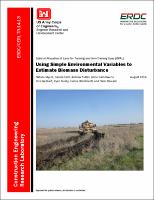Please use this identifier to cite or link to this item:
https://hdl.handle.net/11681/19986Full metadata record
| DC Field | Value | Language |
|---|---|---|
| dc.contributor | United States. Office of the Assistant Secretary of the Army for Acquisition, Logistics, and Technology | - |
| dc.contributor.author | Myers, Natalie R. D. | - |
| dc.contributor.author | Koch, Daniel J. | - |
| dc.contributor.author | Fulton, Andrew J. | - |
| dc.contributor.author | Dain-Owens, Anne P. | - |
| dc.contributor.author | Gebhart, Dick L. | - |
| dc.contributor.author | Busby, Ryan R. | - |
| dc.contributor.author | Westervelt, James D. | - |
| dc.contributor.author | Howard, Heidi R. | - |
| dc.date.accessioned | 2016-10-12T14:04:15Z | - |
| dc.date.available | 2016-10-12T14:04:15Z | - |
| dc.date.issued | 2014-08 | - |
| dc.identifier.uri | http://hdl.handle.net/11681/19986 | - |
| dc.description | Technical Report | - |
| dc.description | Abstract: Proper management of military training lands is critical to ensure availability of training lands, and thereby ensure mission readiness. However, installation land management often supports a broader mission than simply maintaining the land in a condition suitable for training, including activities as agriculture and grazing outleases, and protection of habitat to conserve Federally listed threatened and endangered species. Proactive land management practices that support such potentially conflicting land uses must take a systematic approach that considers, coordinates, and integrates complex land impacts. Development of the Optimal Allocation of Land for Training and Non-Training Uses (OPAL) Program was undertaken to meet this need. This phase of work developed algorithms for estimating cumulative land disturbance on military training lands through above- and below-ground biomass responses. Algorithms developed here specifically focused on four aspects of the relation between above- and below-ground biomass and natural resource disturbance: (1) use of above- and below-ground biomass to quantify disturbance, (2) forecasting soil temperature and moisture as a consequence of weather, (3) distribution of training and its impacts on biomass, and (4) impacts of burning/haying on land management. | - |
| dc.publisher | Construction Engineering Research Laboratory (U.S.) | - |
| dc.publisher | Engineer Research and Development Center (U.S.) | - |
| dc.relation | http://acwc.sdp.sirsi.net/client/en_US/search/asset/1035942 | - |
| dc.rights | Approved for public release; distribution is unlimited. | - |
| dc.source | This Digital Resource was created in Microsoft Word and Adobe Acrobat | - |
| dc.subject | OPAL | - |
| dc.subject | Optimal Allocation of Land for Training and Non-Training Uses | - |
| dc.subject | Land management | - |
| dc.subject | Environmental management | - |
| dc.subject | Military training lands | - |
| dc.subject | Military installations | - |
| dc.subject | Statistical modeling | - |
| dc.title | Using simple environmental variables to estimate biomass disturbance | - |
| dc.type | Report | en_US |
| Appears in Collections: | Technical Report | |
Files in This Item:
| File | Description | Size | Format | |
|---|---|---|---|---|
| ERDC-CERL-TR-14-13.pdf | 1.29 MB | Adobe PDF |  View/Open |